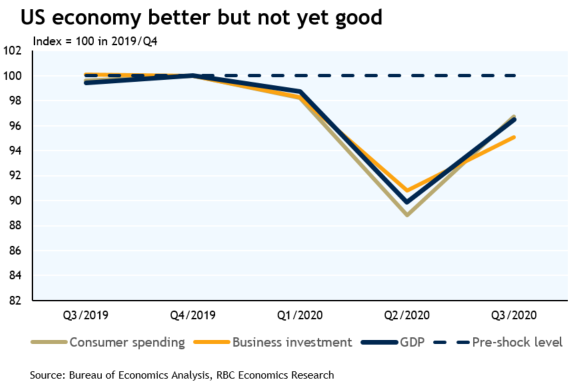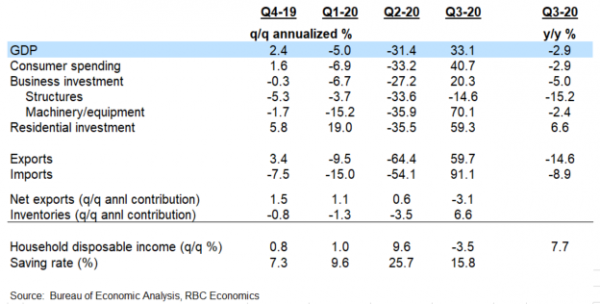- Q3 GDP rose 33% (annualized) after 31% drop in Q2
- Gains widespread although pockets of weakness in non-residential building activity
- Pace of growth to slow going forward
The 33.1% (annualized) jump in Q3 GDP was broadly in line with expectations. The rise only partially retraces 31.4% and 5.0% declines in Q2 and Q1, respectively, leaving activity running 3.5% below its pre-shock (Q4/2019) level. The data nonetheless confirms that the initial bounce-back in activity from the spring COVID-19 related shutdowns was quicker than feared. Consumer spending bounced back 41% after falling 33% in Q2. Residential investment surged almost 60% on a bounce-back in housing markets over the summer. Business investment rose overall, boosted by machinery & equipment purchases. But nonresidential investment in structures was one remaining soft-spot, declining another 14.6% in Q3. Oil & gas exploration activity (unsurprisingly given low oil prices) fell sharply. And declines in investment in office buildings, restaurants, etc. will not quiet concerns about commercial property markets.
And the pace of recovery is expected to slow going forward. Labour markets are still exceptionally soft. Employment has been lagging the GDP recovery (the job count was still down 6 1/2% from year-ago levels at the end of Q3). A larger share of those still off work are on permanent rather than temporary layoff, and so will likely take longer to match with new jobs. Household incomes remain elevated thanks to remaining government support programs – disposable incomes were still up almost 8% from a year ago in Q3 despite the expiry of $600/week federal top-up unemployment insurance payments at the end of July.
Spending on services – particularly on anything tourism/entertainment – is likely to remain soft as long as the virus threat remains. And while governments have been reluctant to reimpose containment measures, accelerating virus spread still means the risk of more stringent lockdowns remains. The early bounce-back in economic activity has been faster than initially feared, but the road to a full recovery still looks long.
















